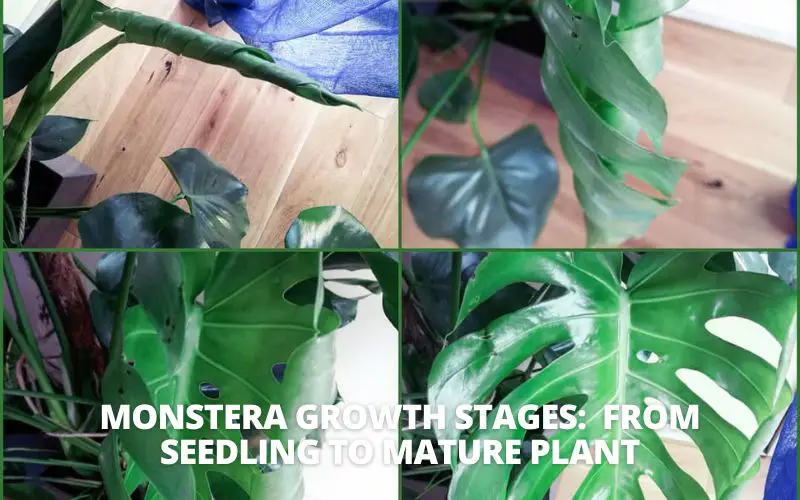If you’re like me, you love Monsteras. They are one of the most popular houseplants around, and for good reason – they are easy to care for and look great in any room. But did you know that Monsteras have different growth stages? In this blog post, we will discuss the four main Monstera growth stages: seedling, juvenile, adult, and senescent. We will also provide tips on how to care for your plant during each stage

Monstera Growth Stages
As with most plants, Monsteras have different growth stages. The four main Monstera growth stages are seedling, juvenile, adult, and senescent. Let’s take a look at each stage in more detail:
1. Seedling
The seedling stage is when your Monstera is first growing from a seed. During this stage, your plant will be very small and delicate. It is important to keep the soil moist during this stage, but not too wet. You should also provide plenty of light, but be careful not to scorch your seedling with direct sunlight.
2. Juvenile
The juvenile stage is when your Monstera starts to develop its iconic leaves with holes. During this stage, your plant will be growing rapidly and will need more water than during the seedling stage. However, you should still be careful not to overwater your plant – Monsteras are susceptible to root rot. You should also provide plenty of light during this stage, as Monsteras need lots of light to grow well.
3. Adult
The adult stage is when your Monstera reaches its full size. During this stage, your plant will need less water than during the juvenile stage. However, you should still be careful not to let the soil dry out completely – Monsteras prefer moist soil. You can also reduce the amount of light during this stage, as Monsteras do not need as much light once they reach adulthood.
4. Senescent
The senescent stage is when your Monstera starts to show signs of aging. During this stage, your plant will need less water and light than during the adult stage. You may also notice that your plant’s leaves start to yellow or brown – this is normal and nothing to worry about. Once your Monstera reaches this stage, it is important to provide extra TLC to keep your plant healthy and happy.

Tips for Caring for Your Monstera
Now that we’ve gone over the different Monstera growth stages, let’s talk about tips for caring for your Monstera during each stage.
- Seedling: As we mentioned before, it is important to keep the soil moist during the seedling stage. You can do this by misting your plant regularly or setting your plant in a tray of water. It is also important to provide plenty of light, but be careful not to scorch your seedling with direct sunlight.
- Juvenile: During the juvenile stage, your plant will need more water than during the seedling stage. However, you should still be careful not to overwater your plant – Monsteras are susceptible to root rot. You should also provide plenty of light during this stage, as Monsteras need lots of light to grow well.
- Adult: Once your Monstera reaches the adult stage, you can reduce the amount of water and light it receives. However, you should still be careful not to let the soil dry out completely – Monsteras prefer moist soil. You can also reduce the amount of light during this stage, as Monsteras do not need as much light once they reach adulthood.
- Senescent: The senescent stage is when your Monstera starts to show signs of aging. During this stage, your plant will need less water and light than during the adult stage. You may also notice that your plant’s leaves start to yellow or brown – this is normal and nothing to worry about. Once your Monstera reaches this stage, it is important to provide extra TLC to keep your plant healthy and happy.
We hope you found this article helpful! If you have any questions about Monstera care, feel free to reach out to us. And be sure to check out our other articles on Monsteras – we cover everything from potting mix to propagating Monsteras. By following these tips, you can be sure that your Monstera will thrive at every stage of its growth! So don’t hesitate to give Monsteras a try – they make for beautiful, low-maintenance houseplants. Thanks for reading!
You may also like: 10 common Monstera in the wild (You can easily find)


